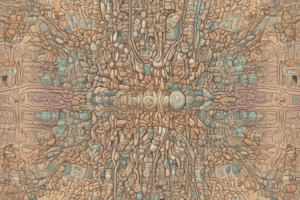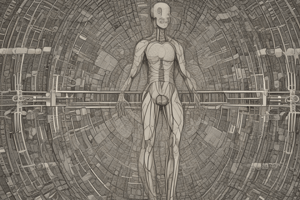Podcast
Questions and Answers
What is pheochromocytoma primarily characterized by?
What is pheochromocytoma primarily characterized by?
- Production of insulin
- Malignant transformation of adrenal cortex
- Excessive production of catecholamines (correct)
- Reduced sympathetic nerve activity
Which medications are typically used first in the management of pheochromocytoma?
Which medications are typically used first in the management of pheochromocytoma?
- Angiotensin-converting enzyme inhibitors
- Calcium channel blockers
- Alpha blockers (correct)
- Beta blockers
What is a common symptom associated with Horner's syndrome?
What is a common symptom associated with Horner's syndrome?
- Constricted pupil (miosis) (correct)
- Blurred vision (amaurosis)
- Dilated pupil (mydriasis)
- Increased sweating (hyperhidrosis)
Which diagnostic method is NOT typically used to confirm Horner's syndrome?
Which diagnostic method is NOT typically used to confirm Horner's syndrome?
What is the primary approach to treating Horner's syndrome?
What is the primary approach to treating Horner's syndrome?
What is the primary function of the sympathetic division of the autonomic nervous system?
What is the primary function of the sympathetic division of the autonomic nervous system?
Which neurotransmitter is predominantly released by postganglionic sympathetic neurons?
Which neurotransmitter is predominantly released by postganglionic sympathetic neurons?
In the autonomic nervous system, which type of receptors does acetylcholine bind to in the parasympathetic division?
In the autonomic nervous system, which type of receptors does acetylcholine bind to in the parasympathetic division?
What is the condition characterized by a tumor on the adrenal gland, which can lead to elevated catecholamine levels?
What is the condition characterized by a tumor on the adrenal gland, which can lead to elevated catecholamine levels?
Which of the following is a typical symptom of pheochromocytoma?
Which of the following is a typical symptom of pheochromocytoma?
Which adrenergic antagonist was given to Helen to manage her condition?
Which adrenergic antagonist was given to Helen to manage her condition?
What is the role of vanillylmandelic acid (VMA) in the assessment of pheochromocytoma?
What is the role of vanillylmandelic acid (VMA) in the assessment of pheochromocytoma?
Which statement about the autonomic nervous system is true?
Which statement about the autonomic nervous system is true?
Flashcards
What is the Autonomic Nervous System?
What is the Autonomic Nervous System?
The Autonomic Nervous System (ANS) controls involuntary bodily functions such as heart rate, digestion, and breathing. It operates without conscious effort.
What is the Sympathetic Nervous System?
What is the Sympathetic Nervous System?
The Sympathetic Nervous System is part of the ANS, preparing the body for 'fight or flight' responses by increasing heart rate, blood pressure, and respiration.
What is the Parasympathetic Nervous System?
What is the Parasympathetic Nervous System?
The Parasympathetic Nervous System is the other branch of the ANS, responsible for 'rest and digest' functions by decreasing heart rate, lowering blood pressure, and promoting digestion.
What is Norepinephrine (NE)?
What is Norepinephrine (NE)?
Signup and view all the flashcards
What is Acetylcholine (Ach)?
What is Acetylcholine (Ach)?
Signup and view all the flashcards
What are Adrenergic and Cholinergic receptors?
What are Adrenergic and Cholinergic receptors?
Signup and view all the flashcards
What are Muscarinic and Nicotinic receptors?
What are Muscarinic and Nicotinic receptors?
Signup and view all the flashcards
What is Pheochromocytoma?
What is Pheochromocytoma?
Signup and view all the flashcards
What are the initial medications used to treat Pheochromocytoma?
What are the initial medications used to treat Pheochromocytoma?
Signup and view all the flashcards
What is Horner's Syndrome?
What is Horner's Syndrome?
Signup and view all the flashcards
What are the common symptoms of Horner's Syndrome?
What are the common symptoms of Horner's Syndrome?
Signup and view all the flashcards
What is the expected management for Horner's Syndrome?
What is the expected management for Horner's Syndrome?
Signup and view all the flashcards
Study Notes
Neurophysiology of the Autonomic Nervous System
- The autonomic nervous system (ANS) controls involuntary functions, like heart rate, digestion, and sweating.
- It's divided into two main branches: sympathetic and parasympathetic.
- Sympathetic: Prepares the body for "fight or flight" responses, mobilizing energy. It typically releases norepinephrine (NE) as a neurotransmitter.
- Parasympathetic: Rest and digest response. It typically releases acetylcholine (ACh) as a neurotransmitter.
- Acetylcholine often affects both branches.
General Organization of the Nervous System
- The nervous system is divided into central and peripheral branches.
- Central Nervous System (CNS): Composed of brain and spinal cord.
- Peripheral Nervous System (PNS): Consists of nerves branching off the CNS to reach all other parts of the body
- Somatic nervous system: Controls voluntary muscle movements.
- Autonomic nervous system (ANS): Controls involuntary functions like heart rate, digestion, and sweating.
- The ANS is further divided into the sympathetic and parasympathetic nervous systems.
ANS Receptors
- Adrenergic receptors respond to norepinephrine and epinephrine, released during sympathetic stimulation. Subtypes include α1, α2, β1, and β2.
- Cholinergic receptors respond to acetylcholine, found in both sympathetic and parasympathetic branches, and have subtypes such as muscarinic (M1, M2, M3), and nicotinic (N1, N2).
Pheochromocytoma
- A tumor of the adrenal medulla that produces excessive catecholamines (primarily adrenaline/epinephrine and noradrenaline/norepinephrine).
- This can cause extreme sympathetic responses, resulting in high blood pressure, headache, sweating, anxiety.
- Diagnosed by elevated urine vanillylmandelic acid (VMA) levels and/or imaging.
- Treatment involves alpha-blockers to initially control blood pressure, then beta-blockers to control heart rate irregularities. Surgery (laparoscopic adrenalectomy) to remove the tumor is often necessary.
- The presented case study describes a patient with symptoms consistent with a pheochromocytoma, and confirms the diagnosis with diagnostic testing..
Horner's Syndrome
- A disorder causing a combination of signs (e.g., drooping eyelid, constricted pupil, decreased sweating on one side of the face ) due to damage to the sympathetic pathways in the head and neck.
- Causes include: carotid artery dissection, tumors in neck/chest cavity, lesions in the midbrain/spinal cord, or inflammation in the neck's lymph nodes.
- Diagnosis is clinical, often corroborated by imaging studies (e.g., X-rays, MRI, CT).
- Treatment focuses on addressing the underlying cause rather than the syndrome itself. Supportive care is common.
Studying That Suits You
Use AI to generate personalized quizzes and flashcards to suit your learning preferences.
Related Documents
Description
Explore the functions and organization of the autonomic nervous system (ANS) in this quiz. You'll learn about its two main branches, sympathetic and parasympathetic, and how they regulate involuntary bodily functions. Delve into the roles of key neurotransmitters like norepinephrine and acetylcholine.



